It's getting hot in here...
- sjpdragonlady
- Jan 23
- 14 min read
Updated: Jan 30

Is our planet really getting warmer over time?
Climate scientists overwhelmingly agree that climate change is happening, and at a rate that is not explained by natural cyclic variations in temperature. According to NASA, while the Earth's climate has changed throughout its history, warming is currently happening at the fastest rate in at least the past 10,000 years. Since 1880 (the "second" Industrial Revolution), the average surface temperature of the Earth has risen by about 1.8°F (1.0°C). During the past 40 years, the global annual temperature has risen by 0.2 degrees Celsius, or 0.36 degrees Fahrenheit, per decade. Since 1981, the rate of increase has more than doubled. The ten most recent years have been the warmest years on record, and 2023 had the highest global temperatures in over 100,000 years!

According to the Environmental Protection Agency:
Since 1901, the average surface temperature across the contiguous 48 states has risen at an average rate of 0.17°F per decade
Temperatures have risen more quickly since the late 1970s (0.32 to 0.51°F per decade since 1979)
Nine of the 10 warmest years on record have occurred since 1998
Globally, 2014–2023 was the warmest decade on record since thermometer-based observations began
Worldwide, 2023 was the warmest year on record
Since the late 1970s, the United States has warmed faster than the global rate.
In the United States, the North, the West, and Alaska have seen temperatures increase the most
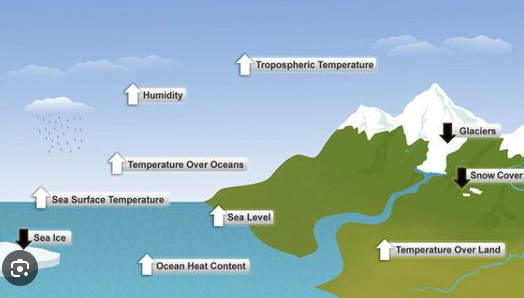
Additional evidence for global warming:
Ocean heat content is increasing
Global sea level is rising
Glacier, snow and ice cover are decreasing
Arctic sea ice is melting
Plants are blooming earlier in the spring
Lobsters and other marine species are moving north
Birds are migrating earlier with different flight patterns
Ocean acidification is increasing; oceans are 30% more acidic than 40 years ago
Ice cores, rocks and tree rings provide data that confirms climate change
Why is the environment getting hotter?

The natural greenhouse effect is the warming of the planet that occurs when atmospheric (greenhouse) gases trap heat from the sun that would otherwise be reflected into space. Under normal circumstances, the greenhouse effect is helpful, as it warms the planet to temperatures that can sustain life. Otherwise, the Earth would be a frozen, uninhabitable place like Mars. Normally, approximately 30% of solar energy is reflected back into space. The remaining 70% is absorbed by the atmosphere where it warms the planet. Some of this heat is then radiated from the planet back into space in the form of infrared radiation. While some of this infrared light continues on into space, the vast majority gets reabsorbed by atmospheric gases, causing further warming. Under typical circumstances, this process creates an equilibrium that maintains a specific temperature range on the surface of the planet.
When concentrations of greenhouse gases, particularly carbon dioxide, increase, extra heat is trapped and global temperatures rise. For most of the past 800,000 years, carbon dioxide concentrations in our atmosphere were between 200 and 280 parts per million. However, in the past century, that concentration has jumped to 420 parts per million—50% higher than preindustrial levels, and higher than any concentrations seen for millions of years. Unless it is offset in some way, this increased atmospheric carbon dioxide leads to warmer surface temperatures.
What are the main greenhouse gasses?
Carbon Dioxide Molecule

Carbon dioxide-- makes up approximately 80% of global human-caused emissions, remains in the atmosphere for a long time (40% remains after 100 years, 20% after 1,000 years, and 10% up to 10,000 years later), comes from burning fossil fuels (coal, oil, natural gas) for purposes of power generation, transportation, industry and agriculture
Methane-- makes up 12% of human-generated greenhouse gas emissions, remains in the atmosphere for approximately 12 years, but has 30 times more impact than carbon dioxide on the greenhouse effect, comes from natural gas production and livestock based agriculture
Nitrous oxide-- makes up 6% of human gas emissions, remains in the atmosphere for more than a century, has a global warming potential that is almost 270 times that of carbon dioxide, comes from agricultural fertilizers
Fluorinated gasses (hydrofluorocarbons, perflurorcarbons, sulfur hexafluoride and nitrogen trifluoride)-- make up only 3% of greenhouse gasses but may remain in the atmosphere for tens of thousands of year and have global warming potential thousands of times higher than carbon dioxide, comes from air conditioners and refrigerators especially when improperly disposed of
Water vapor-- the most abundant greenhouse gas overall, not linked to human activities directly, but rather to the warming that results from the other greenhouse gases emitted by humans, as warmer air holds more water which in turn absorbs more heat, inducing even greater warming
What are the main sources of greenhouse gasses?

Electricity and heat production-- The burning of coal, oil, and gas to produce electricity and heat accounts for one-quarter of worldwide human-driven emissions, making it the largest single source. According to the EPA, in the United States, at 25% it’s the second-largest (behind transportation), releasing primarily carbon dioxide with small amounts of methane and nitrous oxide.
Agriculture and land use-- Approximately one-quarter of global greenhouse gas emissions stem from agriculture and other land uses, including deforestation. In the United States, agricultural activities including raising of livestock and food crops—accounted for 10% of greenhouse gas emissions, predominantly methane (from manure and cows belching) and nitrous oxide (from nitrogen-heavy fertilizers). Clearing land also removes natural vegetation, which worsens the greenhouse effect by decreasing nature's ability to absorb carbon dioxide.
Industry-- One-fifth of global human-driven emissions come from the industrial sector, including the manufacturing of goods and raw materials (like cement and steel), food processing, and construction. Industry accounts for 23% of U.S. man-made emissions, of which the majority is carbon dioxide.
Transportation-- Burning petroleum-based fuels, specifically gasoline and diesel, to power transportation systems accounts for 14% of global greenhouse gas emissions. In the United States, transportation is the largest contributor of greenhouse gases at 28%. Nationwide, cars and trucks are responsible for more than half of transportation-related carbon emissions. Carbon dioxide is the primary gas emitted, with small amounts of methane and nitrous oxide. Vehicle air-conditioning and refrigerated transport also release fluorinated gases.
Residential/Commercial-- Operating buildings generates 6.4% of global greenhouse gases. In the United States, homes and businesses account for 13% of emissions. These emissions stem from burning natural gas and oil for heating and cooking, and are made up primarily of carbon dioxide and methane.
Other sources-- This category includes emissions from energy-related activities other than fossil fuel combustion, such as the extraction, refining, processing, and transportation of oil, gas, and coal. Globally, this accounts for 9.6% of emissions.
Couldn't warming temperatures be a natural variation?
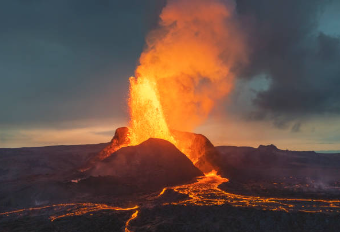
Earth’s climate has changed throughout history. In the last 800,000 years alone, there have been eight cycles of ice ages alternating with warmer periods. The last ice age ended about 11,700 years ago marking the beginning of the modern climate era and the start of human civilization. Since then, the climate has been relatively stable, which was likely critical to the development of human culture. Most of these climate changes are attributed to small variations in the orbit of the Earth’s that change the amount of solar energy our planet receives. The current warming trend is different in that it is clearly associated with human activities since the mid-1800s, and is proceeding at a rate not seen over many millennia.

Cornell University has observed that more than 99.9% of scientific studies agree that human activity is driving climate change. According to NASA, ice cores drawn from Greenland, Antarctica, and tropical mountain glaciers confirm that Earth’s climate is responding to increases in greenhouse gas levels. Evidence can also be found in tree rings, ocean sediments, coral reefs, and layers of sedimentary rocks indicating that current warming is occurring 10 times faster than the average rate of warming after an ice age. Carbon dioxide from human activities is increasing approximately 250 times faster than it did from natural sources after the last Ice Age. The National Oceanic and Atmospheric Administration observes that because of the rapid increase and isotopic “fingerprint” of recent carbon dioxide deposits, this carbon dioxide stems from fossil fuels, and not natural sources like forest fires, volcanoes, or outgassing from the ocean.
Tree rings showing wider rings in warm, wet years
Does it matter if the Earth is getting hotter?
Rising temperatures lead to severe impacts on our environment and ecosystem, affecting the plants, animals and people living in these areas. Increasing heat leads to sea level rise, which exacerbates droughts and floods, and shifts wildlife habitats. Of particular concern is the impact of global warming on Earth's polar regions and mountain glaciers. The Arctic is warming four times faster than the rest of the planet. This warming reduces critical ice habitat and it disrupts the flow of the jet stream, creating more unpredictable weather patterns around the globe. As the planet warms, the air holds about more moisture which can produce flash floods, more destructive hurricanes, and stronger snow storms. Increasing temperatures and changing precipitation patterns are making wildfires more frequent and widespread, extending into historically uncommon areas such as the northwestern US. According to National Geographic, reconstruction of Earth's average temperature over the past 485 million years demonstrates that when the planet warms, catastrophic weather and mass extinctions follow.
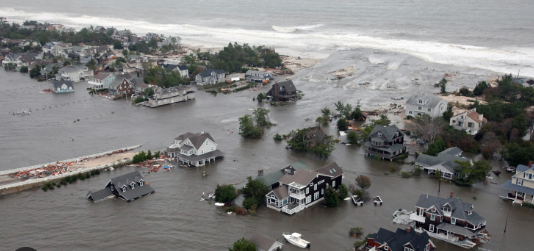
Climate change directly impacts the health of all living things. Trees are dying from drought, which is significantly altering forest ecosystems. Coral reefs are suffering from coral bleaching as a result of warming waters, and are rapidly becoming endangered. Rising temperatures alter the homes of animals, impacting access to water, and vegetation that provides shelter and food sources. Ecosystems may become unsuitable for some animals, forcing wildlife to migrate outside of their usual patterns in search of food and livable conditions, and threatening their survival. Some may become extinct as they become isolated from necessary resources. The Intergovernmental Panel on Climate Change suggests that up to 60% of the world's species may be threatened by warming habitats.
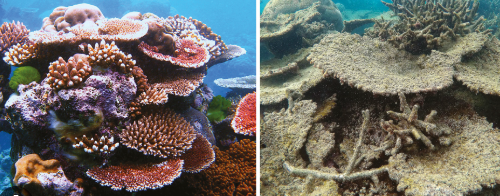
In addition to dramatically altering our environment (which can affect our mental and emotional health), heat has a direct impact on human wellbeing. On average, between the years of 2018 and 2022, people experienced health-threatening heat for approximately 86 days per year. With global warming, this span is expected to increase. The World Health Organization observed that since the year 2000, approximately 489,000 heat-related deaths have occurred each year High intensity heatwave events significantly impact mortality. Climate scientists estimate that global warming will double the risk of many heat-related illnesses. According to the Lancet, if global temperatures rise almost 2 degrees Celsius, the annual number of heat-related deaths may increase by 370 percent (almost fivefold).

How can heat harm our health?
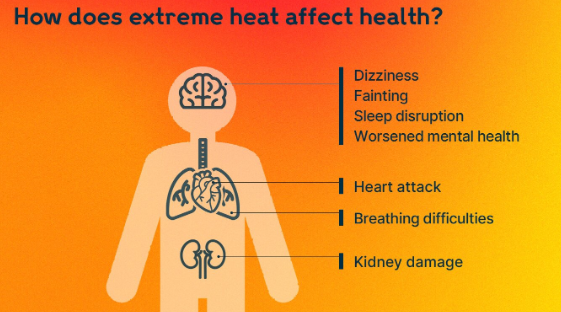
Heat stress is the leading cause of weather-related deaths. It can also exacerbate underlying illnesses including cardiovascular disease, diabetes, mental health and asthma. Research indicates that deaths from heart attacks or strokes may be two or three times more likely in the context of extreme heat. Increasing temperatures are also associated with a higher risk of accidents, air pollution, food insecurity and transmission of some infectious. In extremely hot environments, people experience problems such as dizziness, fainting, disrupted sleep, breathing problems, heat exhaustion, heart attacks and kidney problems. In severe cases, extreme heat can lead to heatstroke (when the body temperature rises above 40°C) and organ failure. Heatstroke is a medical emergency with a high mortality rate.
Who is at risk for heat-related illnesses?

Pregnancy can make individuals more susceptible to heat-related illnesses because the body has to work harder to cool down both the pregnant person and their fetus. Pregnancy induced hypertension, stillbirth and low birth weight have been associated with extreme heat.
Infants and young children can be vulnerable to extreme heat because they sweat less than adults and can’t regulate their body temperature as well as adults.
Adults over 65 have reduced sweating ability and struggle to cool themselves in extreme heat. Elderly individuals are particularly at risk for heat-related deaths.
People with underlying health conditions such as heart or lung disease, mental illness and poor circulation are susceptible to extreme heat. Certain medications can increase this risk.
Individuals who are overweight and obese tend to retain body heat, making them more susceptible to heat.
Outdoor workers, such as carpenters and agricultural workers suffer from the effects of exertion in extreme weather conditions.
Citizens with low income may not be able to easily access cooling technologies.
More than half the world's population live in cities where heat is intensified by closely constructed buildings, lots of people and many vehicles. These areas act as heat islands and city residents will have more difficulty cooling off on hot days.
People of color may be more likely to live in urban heat islands, work in hot environments and have lower incomes, putting them at higher risk.
AP News
Extreme heat is incredibly dangerous for people who work outdoors! This includes critical workers such as builders, carpenters, road workers, agriculturalists and farm workers, among many others. There are significant personal, social and economic costs associated with heat related illness. As the environment gets warmer, there is an increased risk of health problems like heat exhaustion, heat stroke, traumatic injuries, heart attacks, strokes and kidney disease. According to the National Institute of Health, farmworkers are 35 times more likely to die of heat-related illnesses than workers in other industries. Efficiency also decreases significantly as ambient temperatures rise, which means that outdoor work is done less quickly. If the people who build your homes and provide your food are unwell or unable to do their work effectively, time is wasted and the price of homes and food increases!
OSHA guidelines for protecting yourself from heat illness:
During their first few days in warm or hot environments, employers should encourage workers to:
Consume adequate fluids (water and sport drinks)
Work shorter shifts
Take frequent breaks
Quickly identify any heat illness symptoms
Get used to the heat slowly to build up your tolerance
50% to 70% of heat-related fatalities occur in the first few days of working in warm or hot environments! START SLOW!
What medications increase the risk for heat-related illness?
According to the Center for Disease Control...
Medications that make individuals more prone to heat illness include:
diuretics (water pills)
anticholinergics (used for lung, bladder and gastrointestinal disease)
psychotropics (antidepressants such as SSRIs and tricyclic antidepressants)
combination medications such as blood pressure meds combining ACE inhibitors (lisinopril) with diuretics
antihistamines (allergy meds)
stimulants (attention deficit medications)
Medications can contribute to heat sensitivity in the following ways:
Reduced thirst sensation (diuretics, ACE inhibitors, ARBS).
Interference with central thermoregulation (antipsychotics, anticholinergics, stimulants).
Impaired sweating and therefore impaired cooling (increased with Selective Serotonin Reuptake Inhibitors (SSRIs), Serotonin and Norepinephrine Reuptake Inhibitors (SNRIs), decreased with Tricyclic Antidepressants (TCAs), typical and atypical antipsychotics, anticholinergic agents).
Volume depletion, hypotension, and/or reduced cardiac output with increased risk of fainting and falls, and potentially reduced renal blood flow and renal injury from nephrotoxic drugs, as can happen with non-steroidal anti-inflammatory drugs (NSAIDs) (diuretics, beta blockers, TCAs, laxatives).
Reduced blood vessel dilation and impaired ability to dissipate heat (aspirin, beta-blockers, and clopidogrel).
Drug toxicity from reduced clearance of medications in people who are dehydrated, especially for medications with a narrow therapeutic index (apixaban, carbamazepine, and lithium).
Electrolyte imbalance (diuretics, beta blockers, calcium channel blockers, antacids, laxatives, lithium, and trimethoprim-sulfamethoxazole).
Sedation or cognitive impairment with increased risk of falls and reduced thirst sensation (opiates, benzodiazepines, typical and atypical antipsychotic medications, antidepressants, anticonvulsants).
If you live in areas with days of extreme heat, and take any of the above medications, ask your doctor about the best ways to use them safely. Never abruptly stop your medications without professional input!
What are the symptoms of heat-related illnesses?

Symptoms of heat related illness can include:
Muscle cramping
Unusually heavy sweating
Shortness of breath
Dizziness
Headaches
Weakness
Chest Pain

IF YOU HAVE SYMPTOMS SUSPICIOUS FOR HEAT EXHAUSTION AND ARE NOT IMPROVING WITH COOLING AND HYDRATION, OR ANY SYMPTOMS OF HEATSTROKE, GO TO THE EMERGENCY ROOM IMMEDIATELY!
How can heat-related illnesses be treated?



How can I prevent heat-related illness?

The Center for Disease Control suggests:
Stay cool and stay hydrated-- know where your local cooling centers are if needed.
Keep in mind that heavy sweating can remove salt and minerals from your body. Talk to your doctor about how to safely replace salt and minerals lost through sweating.
Do not engage in very strenuous activities and get plenty of rest.
Check on a friend or neighbor and have someone do the same for you.
Check your local Heat Risk and Air Quality for recommendations.
Have a plan for your medicine-- many medicines can make you dehydrated or overheated on hot days and some medicines need to be kept out of hot places.
Heat can cause power outages. Have a plan for what to do with refrigerated medications and electronic medical devices.
Store your medicines properly- some may need to be kept out of hot places

Johns Hopkins Medical School recommends:
Drink plenty of fluids during vigorous or outdoor activities especially on hot days. Drinks of choice include water and sports drinks; avoid alcohol and fluids with caffeine, such as tea, coffee, and cola, as these can lead to dehydration.
Avoid sunbathing, especially on hot days.
Dress in light colored, lightweight, tightly-woven, loose-fitting clothing on hot days.
Schedule vigorous activity and sports for cooler times of the day. Take rest periods in shady or cool areas.
Protect yourself from the sun and wears a hat and sunglasses, or use an umbrella. Use a sunscreen that is at least SPF (sun protection factor) 15.
Increase time spent outdoors gradually to get your body used to the heat.
Take frequent drink breaks and "wet down" or mist yourself with a spray bottle to avoid becoming overheated.
Try to spend as much time indoors as possible on very hot and humid days.
Warm-up and cool-down before and after exercising.
If you have a medical condition or is taking medicine, consult your doctor for further advice for preventing heat-related illnesses.
Can global warming be reversed?
Artificial Carbon Capture

Someday, we may have the technology to absorb carbon dioxide from the atmosphere and store it safely, where it can't contribute to warming temperatures. The reality is that it will likely take some time before our technology and infrastructure is sufficient for this task. For now, the priority involves addressing the root cause of global warming by reducing emissions of greenhouse gases from human activities. Mitigation of climate change, by reducing emissions and protecting natural carbon sinks, remains the best way to minimize climate change in the future.
Once we reduce greenhouse gas emissions, it will still take time to see improvements in climate change. According to the National Oceanic and Atmospheric Association, if all human emissions of heat-trapping gases were to stop today, Earth’s temperature would continue to rise for a few decades as ocean currents bring heat stored in the deep ocean back to the surface. Once this heat radiates out to space, the Earth’s temperature would stabilize, natural processes would slowly remove the excess carbon dioxide from the atmosphere, and global temperatures would gradually drop. MIT researchers hypothesize that if humans stop all climate pollution by 2030, the Earth will cool by only half a degree Celsius by the end of the 21st century, and remain half a degree above “normal” in the year 2300. While the recovery process will take time, these goals are realistic and can be accomplished. The decisions we make and actions we take now are critical steps in meeting the goal of stopping and reversing climate change.

According to the World Wildlife Fund, renewable energy helps decrease reliance on fossil fuels, and is quite affordable! Solar and wind power are the cheapest ways of generating electricity-- less expensive than nuclear, gas and other fossil fuels. Some estimates indicate that renewable energy can be nine times cheaper than gas. Right now, the costs of energy and food are increasing, driven by the price of fossil fuels, crop failure secondary to climate-related droughts and floods, and inefficient labor in the context of unhealthy environments. Using alternative energies is a great strategy that addresses all these issues.
Someday, we may have the ability to effectively collect and store large quantities of carbon dioxide, through the use of carbon capture technology. The Millennium Technology Prize describes several potential approaches.
Artificial carbon-trapping technologies may efficiently capture carbon in large amounts and store it. Artificial carbon sinks can do some of the work that natural carbon sinks can't perform sufficiently.
Direct Air Capture (DAC) technologies extract CO2 directly from the atmosphere. The system works by drawing air into a large collector system, using a series of giant fans and then using a series of chemical processes to purify the air. The captured carbon dioxide can be safely stored in underground rocks, pumped to the bottom of the sea, or recycled and used as a raw material for fuels, cement and plastics.
CO2 can also be captured when it is produced as a by-product at cement works and biomass power stations. It can also be removed in the production of natural gas, processed and safely stored.
Artificial trees can be sprayed with special chemical compounds to help them absorb CO2.
The surface of the seas can be fertilized with iron to aid in carbon capture by stimulating the growth of CO2-absorbing microorganisms. There are, however, concerns over how effective this method is and whether it could damage oceans’ ecological balance by creating too much phytoplankton, blocking out sunlight or taking nutrients from other creatures.
CO2 can be recycled and reused as a valuable material in the production of the items such as plastic, mattresses and sports floors. It can be utilized in making graphene, which is used to create screens for smartphones and other tech devices.
What can I do to help the environment and limit global warming?

No one can do everything, but everyone can do something! Do what you can!
Save energy at home-- less electricity and heat means less use of coal, oil and gas
Change your home's source of energy-- use solar, wind or geothermal power
Walk, bike or take public transport-- drive your car less
Switch to an electric vehicle if possible
Consider your travel-- buy carbon offsets when you fly
Reduce, reuse, repair and recycle
Eat more vegetables and less meat
Throw away less food-- compost what you can
Plant native species
Clean up trash in your environment
Purchase goods and services mindfully
Advocate to your leaders, family, friends, neighbors and local businesses



Calculate your climate footprint, and look for ways to decrease it!





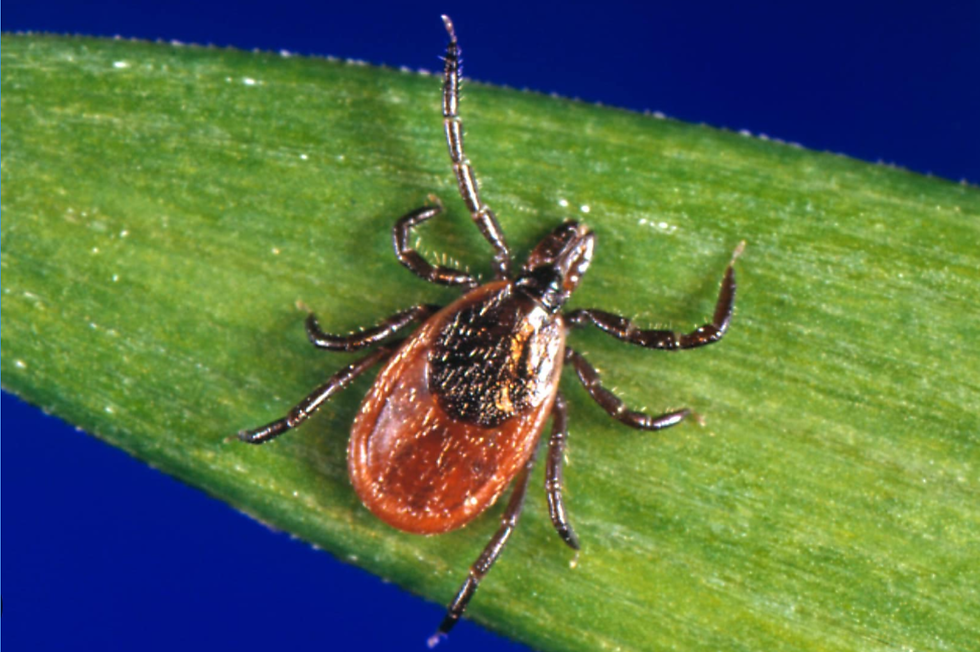


Comments